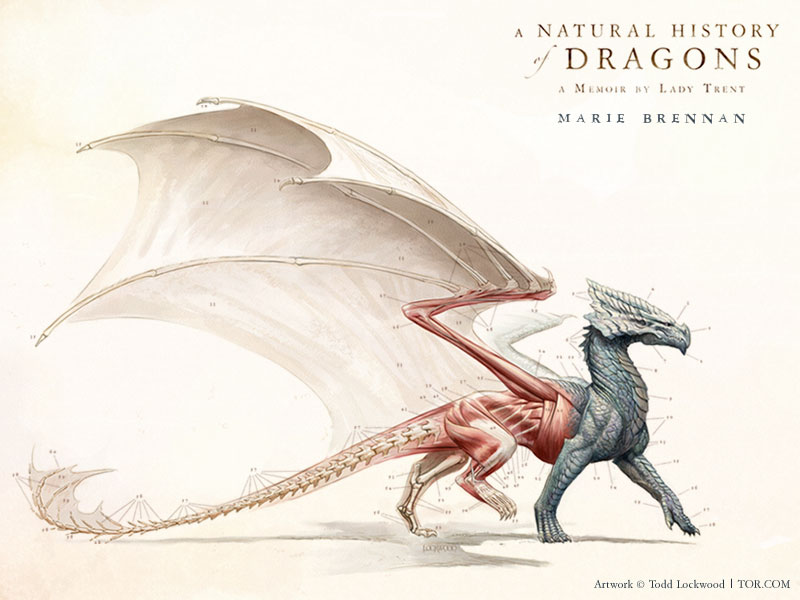In this ancient and nearly forgotten age lie the modest origins of my immodest career: my childhood and my first foreign expedition, to the mountains of Vrystana.
I have a confession to make. As a fan of the Onyx Court series, and the intelligent, layered use Brennan made of history there, I’ve been looking forward to reading A Natural History of Dragons since I first heard it was to be published. And it didn’t disappoint me in the least*—in fact, I’m already pretty sure it’ll be one of my favourite books of the year. (Read an excerpt here.)
*As the trail of my small-hours squeeing on Twitter after I finished it will attest.
A Natural History of Dragons marks Brennan’s first return to novel-length second-world fantasy since her second book. The intervening years have seen a marked improvement in the quality and complexity of her writing: A Natural History of Dragons is the work of a mature writer, confident in voice and execution.
It’s voice that makes this book such a treat: the voice of Isabella Camherst, née Hendemore, a woman whose passion for dragons and for natural philosophy begins—as we see—very early in her girlhood, even though it is not precisely a respectable past-time for a woman in Isabella’s world.
Brennan seems to have modelled Isabella’s homeland on late Georgian/early Victorian England: a place with strongly-defined gender roles, country gentlemen whose families—particularly daughters—are expected to be brought up to manners and an arranged marriage, and where natural philosophy is a respectable hobby for gentlemen of means. The book begins in Isabella’s childhood, where her passion for natural history—and for dragons—is born after successfully preserving a dragon-like insect in vinegar. Childhood adventures and misadventures follow swiftly, and very soon Isabella is an adult, married to one Jacob Camherst: a fortunate match, since Camherst shares Isabella’s interests and is willing to share his library. Shortly thereafter, Isabella contrives to arrange for both Jacob and, against all propriety, herself, to join Lord Hilford’s dragon-studying expedition to Vrystana.
Engaging thus far, it’s here the novel really takes flight. The tone of a retrospective memoir permits Brennan to balance her youthful protagonist’s ignorance and colonial arrogance with more mature reflection on the perspectives of the “backwards” Vrystani villagers around her. Brennan also captures effortlessly the enthusiasm for discovery, along with the long stretches of boredom and difficulty, that attends any scientific endeavour. Isabella’s awe and enthusiasm for dragons are infectious, and the amount of thought Brennan’s put into her worldbuilding is impressive. Only the top layers appear on the page, but it feels solid all the way down. There’s depth: anyone looking for the chipboard behind the curtain will find realism instead.
But in addition to impressively well-thought-out worldbuilding and a compelling voice, A Natural History of Dragons has bandits, dragons that have mysteriously become far more aggressive than usual, dragon dissections, possibly-supernatural goings-on, and intrigue. You mean, you didn’t think there’d be intrigue? We’re speaking of Marie Brennan, after all.
Isabella’s relationship with her husband matures and deepens, as does her proficiency and ambitions as a dragon naturalist. At the same time, she has to deal with the villagers’ fear that she’s brought down a supernatural curse upon them, for exploring some abandoned ruins nearby. When her investigations reveal a more mundane cause, the local lord invites the naturalising party to stay with him, and Isabella stumbles over the source of the troubles plaguing the dragon-studying expedition….
I enjoyed this book a hell of a lot, but it’s not perfect. Isabella acquires information by stumbling over it a bit too often for plausibility’s sake: the coincidences that move the plot forward are a little too transparently coincidental in the aggregate than they are individually. But if I’m honest, I’d forgive far more flaws than this in order to read about Isabella’s adventures. In fact, for a character this interesting with a voice this engaging? I could forgive almost anything.
Luckily for me, there’s not a lot to forgive. A Natural History of Dragons is a mellow and agreeable memoir, an absorbing and entertaining novel, and I want more.
Tell me there’s a sequel.
A final note on the illustrations: Todd Lockwood has done a brilliant job with the book’s handful of beautiful and utterly appropriate images. They’re well worth staring at in full size.
Liz Bourke has too many books and not enough time. Find her on Twitter @hawkwing_lb.










